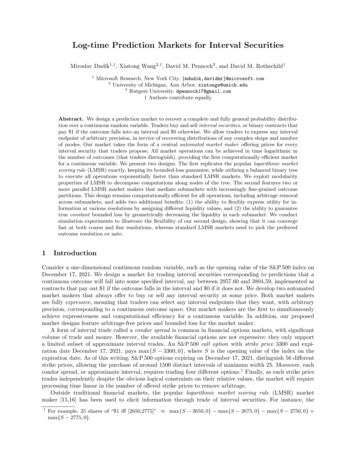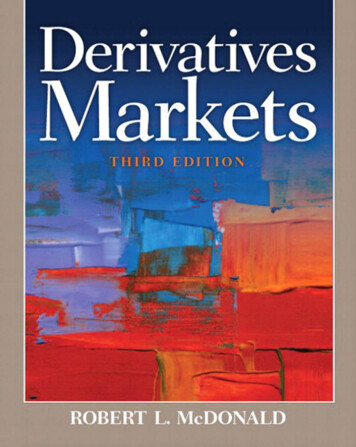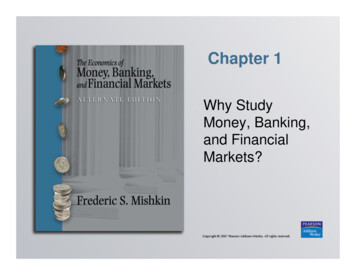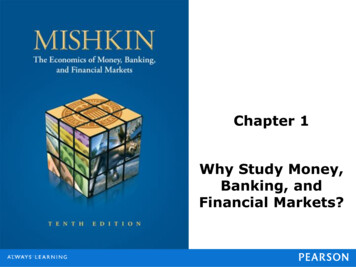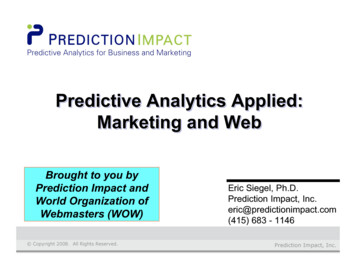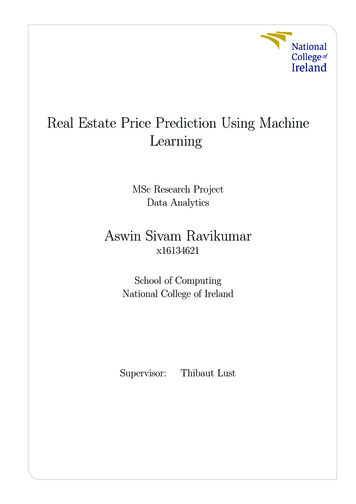
Transcription
Algorithmica manuscriptGaming Prediction Markets: Equilibrium Strategieswith a Market Maker!Yiling Chen1 , Stanko Dimitrov2 , Rahul Sami3 , Daniel M. Reeves4 , David M.Pennock4 , Robin D. Hanson5 , Lance Fortnow6 , Rica Gonen71234567Harvard University, School of Engineering and Applied Sciences, Cambridge, MAUniversity of Michigan, Dept. of Industrial and Operations Engineering, Ann Arbor, MIUniversity of Michigan, School of Information, Ann Arbor, MIYahoo! Research, New York, NYGeorge Mason University, Department of Economics, Fairfax, VANorthwestern University, EECS Department, Evanston, ILYahoo! Research, Santa Clara, CAReceived: 2 June 2008 / Accepted: 29 April 2009Abstract We study the equilibrium behavior of informed traders interacting withmarket scoring rule (MSR) market makers. One attractive feature of MSR is that itis myopically incentive compatible: it is optimal for traders to report their true beliefs about the likelihood of an event outcome provided that they ignore the impactof their reports on the profit they might garner from future trades. In this paper, weanalyze non-myopic strategies and examine what information structures lead totruthful betting by traders. Specifically, we analyze the behavior of risk-neutraltraders with incomplete information playing in a dynamic game. We considerfinite-stage and infinite-stage game models. For each model, we study the logarithmic market scoring rule (LMSR) with two different information structures:conditionally independent signals and (unconditionally) independent signals. Inthe finite-stage model, when signals of traders are independent conditional on thestate of the world, truthful betting is a Perfect Bayesian Equilibrium (PBE). Moreover, it is the unique Weak Perfect Bayesian Equilibrium (WPBE) of the game.In contrast, when signals of traders are unconditionally independent, truthful betting is not a WPBE. In the infinite-stage model with unconditionally independentsignals, there does not exist an equilibrium in which all information is revealedin a finite amount of time. We propose a simple discounted market scoring rulethat reduces the opportunity for bluffing strategies. We show that in any WPBE for!Preliminary versions of some of the results in this paper were presented in twoconference papers, Chen et al. [10] and Dimitrov and Sami [13].This is an author-created version. The original publication is available atwww.springerlink.com. DOI 10.1007/s00453-009-9323-2.
2Y. Chen et al.the infinite-stage market with discounting, the market price converges to the fullyrevealing price, and the rate of convergence can be bounded in terms of the discounting parameter. When signals are conditionally independent, truthful bettingis the unique WPBE for the infinite-stage market with and without discounting.Key words Prediction markets, game theory, bluffing, strategic betting1 IntroductionIt has long been observed that, because market prices are influenced by all thetrades taking place, they reflect the combined information of all the traders. Thestrongest form of the efficient markets hypothesis [14] posits that information isincorporated into prices fully and immediately, as soon as it becomes available toanyone. A prediction market is a financial market specifically designed to take advantage of this property. For example, to forecast whether a product will launch ontime, a company might ask employees to trade a security that pays 1 if and onlyif the product launches by the planned date. Everyone from managers to developers to administrative assistants with different forms and amounts of informationcan bet on the outcome. The resulting price constitutes their collective probabilityestimate that the launch will occur on time. Empirically, such prediction marketsoutperform experts, group consensus, and polls across a variety of settings [16, 17,28, 3, 4, 18, 31, 12, 8].Yet the double-sided auction at the heart of nearly every prediction market isnot incentive compatible. Information holders do not necessarily have incentive tofully reveal all their information right away, as soon as they obtain it. The extremecase of this is captured by the so-called no trade theorems [26]: When rational,risk-neutral agents with common priors interact in an unsubsidized (zero-sum)market, the agents will not trade at all, even if they have vastly different information and posterier beliefs. The informal reason is that any offer by one trader isa signal to a potential trading partner that results in belief revision discouragingtrade.The classic market microstructure model of a financial market posits two typesof traders: rational traders and noise traders [24]. The existence of noise tradersturns the game among rational traders into a positive-sum game, thereby resolvingthe no-trade paradox. However, even in this setting, the mechanism is not incentive compatible. For example, monopolist information holders will not fully revealtheir information right away: instead, they will leak their information into the market gradually over time to obtain a greater profit [7].Instead of assuming or subsidizing noise traders, a prediction market designermight choose to directly subsidize the market by employing an automated market maker that expects to lose money. Hanson’s market scoring rule market maker(MSR) is one example [20, 21]. MSR requires a patron to subsidize the market butguarantees that the patron cannot lose more than a fixed amount set in advance,regardless of how many shares are exchanged or what outcome eventually occurs.The greater the subsidy, the greater the effective liquidity of the market. Since
Gaming Prediction Markets: Equilibrium Strategies with a Market Maker3traders face a positive-sum game, even rational risk-neutral agents have incentiveto participate. In fact, even a single trader can be induced to reveal information,something impossible in a standard double auction with no market maker. Hansonproves that myopic risk-neutral traders have incentive to reveal all their information. However, forward-looking traders may not.Though subsidized market makers improve incentives for information revelation, the mechanisms are still not incentive compatible. Much of the allure ofprediction markets is the promise to gather information from a distributed groupquickly and accurately. However, if traders have demonstrable incentives to either hide or falsify information, the accuracy of the resulting forecast may be inquestion. One frequent concern about incentives in prediction markets is based onnon-myopic strategies: strategies in which the attacker sacrifices some profit earlyin order to mislead other traders, and then later exploit erroneous trades by othertraders, thereby gaining an overall profit.1.1 Our ResultsIn this paper, we study strategies under a logarithmic market scoring rule (LMSR)in a Bayesian extensive-form game setting with incomplete information. We showthat different information structures can lead to radically different strategic properties by analyzing two natural classes of signal distributions: conditionally independent signals and unconditionally independent signals.For conditionally independent signals, we show that truthful betting is a Perfect Bayesian Equilibrium in finite-stage and infinite-stage models. Further, weshow that the truthful betting equilibrium is the unique Weak Perfect BayesianEquilibrium in this setting. Thus, bluffing strategies are not a concern.In contrast, when signals are unconditionally independent, we show that truthful betting is not a Weak Perfect Bayesian Equilibrium in the finite-stage model.In the infinite-stage model, we show that there is no Weak Perfect Bayesian Equilibrium that results in full information revelation in a finite number of trades. Wepropose and analyze a discounted version of the LMSR that mitigates the strategichazard. In the discounted LMSR, we prove that under any WPBE strategy, the relative entropy between the market price and the optimal full-information price tendsto zero at an exponential rate. The rate of convergence can be bounded in terms ofthe discounting parameter and a measure of complementarity in the informationsetting.1.2 Related WorkTheoretical work on price manipulation in financial markets [1, 7, 23] explains thelogic of manipulation and indicates that double auctions are not incentive compatible. This literature has studied manipulation based on releasing false information(perhaps through trades in other markets), as well as manipulation that only requires strategic manipulation in a single market. The latter form of manipulationis closely related to our study here. Allen and Gale [1] describe a model in which
4Y. Chen et al.a manipulative trader can make a deceptive trade in an early trading stage and thenprofit in later stages, even though the other traders are aware of the possibility ofdeception and act rationally. They use a stylized model of a multi-stage market; incontrast, we seek to exactly model a market scoring rule model. Apart from otheradvantages of detailed modeling, this allows us to construct simpler examples ofmanipulative scenarios: Allen and Gale’s model [1] needs to assume traders withdifferent risk attitudes to get around no-trade results, which is rendered unnecessary by the inherent subsidy with a market scoring rule mechanism. Our modelrequires only risk-neutral traders and exactly captures the market scoring rule prediction markets. We refer readers to the paper by Chakraborty and Yilmaz [7] forreferences to other research on manipulation in financial markets.There are some experimental and empirical studies on price manipulation inprediction markets using double auction mechanisms. The results are mixed, somegiving evidence for the success of price manipulation [19] and some showing therobustness of prediction markets to price manipulation [6, 22, 29, 30].Feigenbaum et al. [15] also study prediction markets in which the informationaggregation is sometimes slow, and sometimes fails altogether. In their setting, theaggregation problems arise from a completely different source: the traders are nonstrategic but extracting individual traders’ information from the market price is difficult. Here, we study scenarios in which extracting information from prices wouldbe easy if traders were not strategic; the complexity arises solely from the use ofpotentially non-myopic strategies. Nikolova and Sami [27] present an instance inwhich myopic strategies are not optimal in an extensive-form game based on themarket, and suggest (but do not analyze) using a form of discounting to reducemanipulative possibilities in a prediction market.Axelrod et al. [2] also propose a form of discounting in an experimentalparimutuel market and show that it promotes early trades. Unlike the parimutuelmarket, the market scoring rule has an inherent subsidy, so it was not obvious thatdiscounting would have strategic benefits in our setting as well.Börgers et al. [5] study when signals are substitutes and complements in ageneral setting. Our equilibrium and convergence result suggests that predictionmarkets are one domain where this distinction is of practical importance.This paper is a synthesis and extension of two independent sets of results,which were presented in preliminary form by Chen et al. [10] and Dimitrov andSami [13].1.3 Structure of the PaperThis article is organized as follows: In section 2, we present a little backgroundinformation about market scoring rules. Section 3 details our formal model andinformation structures. In Section 4 we investigate how predefined sequence ofplay affects players’ expected profits in LMSR. In Section 5 we consider, whena player can choose to play first or second, what is its equilibrium strategy ina 2-player LMSR. Results of Sections 4 and 5 serve as building blocks for ouranalysis in subsequent sections. Section 6 studies the equilibrium of a 2-player,
Gaming Prediction Markets: Equilibrium Strategies with a Market Maker53-stage game. We generalize this result to arbitrary finite-player finite-stage gamesin Section 7. We analyze infinite-stage games in Section 8. Section 9 proposesa discounted LMSR and analyzes how the mechanism discourages non-truthfulbehavior. Finally, we conclude in Section 10.2 BackgroundConsider a discrete random variable X that has n mutually exclusive and exhaustive outcomes. Subsidizing a market to predict the likelihood of each outcome, market scoring rules are known to guarantee that the market maker’s loss isbounded.2.1 Market Scoring RulesHanson [20, 21] shows how a proper scoring rule can be converted into a marketmaker mechanism, called market scoring rules (MSR). The market maker uses aproper scoring rule, S {s1 (r), . . . , sn (r)}, where r !r1 , . . . , rn " is a reportedprobability estimate for the random variable X. Conceptually, every trader in themarket may change the current probability estimate to a new estimate of its choiceat any time as long as it agrees to pay the scoring rule payment associated with thecurrent probability estimate and receive the scoring rule payment associated withthe new estimate. If outcome i is realized, a trader that changes the probabilityestimate from r to r̃ pays si (r) and receives si (r̃).Since a proper scoring rule is incentive compatible for risk-neutral agents, if atrader can only change the probability estimate once, this modified proper scoringrule still incentivizes the trader to reveal its true probability estimate. However,when traders can participate multiple times, they might have incentive to manipulate information and mislead other traders.Because traders change the probability estimate in sequence, MSR can bethought of as a sequential shared version of the scoring rule. The market makerpays the last trader and receives payment from the first trader. An MSR marketcan be equivalently implemented as a market maker offering n securities, eachcorresponding to one outcome and paying 1 if the outcome is realized [20, 9].Hence, changing the market probability of outcome i to some value ri is the sameas buying the security for outcome i until the market price of the security reachesri . Our analysis in this paper is facilitated by directly dealing with probabilities.A popular MSR is the logarithmic market scoring rule (LMSR) where thelogarithmic scoring rulesi (r) b log(ri )(b 0),(1)is used. A trader’s expected profit in LMSR directly corresponds to the conceptof relative entropy in information theory. If a trader with probability r̃ moves themarket probability from r to r̃, its expected profit (score) in LMSR isS(r, r̃) n!i 1r̃i (si (r̃) si (r)) bn!i 1r̃i logr̃i bD(r̃ r).ri(2)
6Y. Chen et al.D(p q) is the relative entropy or Kullback Leibler distance between two probability mass functions p(x) and q(x) and is defined in [11] asD(p q) !xp(x) logp(x).q(x)D(p q) is nonnegative and equals zero only when p q. The maximum amounta LMSR market maker can lose is b log n. Since b is a scaling parameter, withoutloss of generality we assume that b 1 in the rest of the paper.2.2 TerminologyTruthful betting (TB) for a player in MSR is the strategy of immediately changingthe market probability to the player’s believed probability. In other words, it is thestrategy of always buying immediately when the price is too low and selling whenthe price is too high. “Too low” and “too high” are determined by the player’s information. The price is too low when the current expected payoff is higher than theprice, and too high when current expected payoff is lower than the price. Truthfulbetting fully reveals a player’s payoff-relevant information. Bluffing is the strategyof betting contrary to one’s information in order to deceive future traders, withthe intent of capitalizing on their resultant misinformed trading. This paper investigates scenarios where traders with incomplete information have an incentive todeviate from truthful betting.13 LMSR in a Bayesian FrameworkIn this part, we introduce our game theoretic model of LMSR market in order tocapture the strategic behavior in LMSR when players have private information.3.1 General SettingsWe consider a single event that is the subject of our predictions. Ω {Y, N } isthe state space of this event. The true state, ω Ω, is picked by nature accordingto a prior p0 !p0Y , p0N " !Pr(ω Y ), Pr(ω N )". A market, aiming atpredicting the true state ω, uses a LMSR market maker with initial probability0estimate r0 !rY0 , rN".There are m risk neutral players in the market. Each player i gets a privatesignal, ci , about the state of the world at the beginning of the market. Ci is thesignal space of player i with Ci ni . The actual realization of the signal isobserved only by the player receiving the signal. The joint distribution of the truestate and players’ signals, P : Ω C1 · · · Cm & [0, 1], is common knowledge.1With complete information, traders should reveal all information right away in MSR,because the market degenerates to a race to capitalize on the shared information first.
Gaming Prediction Markets: Equilibrium Strategies with a Market Maker7Players trade sequentially, in one or more stages of trading, in the LMSR market. Players are risk-neutrual Bayesian agents. If a player i is designated to tradeat some stage k in the sequence, it can condition its beliefs of the likelihood of anoutcome on its private signals, as well as the observed prices after the first k 1trades.Up to this point, we have not made any assumptions about the joint distributionP. It turns out that the strategic analysis of the market depends critically on independence properties of players’ signals. We study two models of independence –independence conditional on the true state, and unconditional independendence –that are both natural in different settings. These are described below.3.1.1 Games with Conditionally Independent (CI) Signals We start with a concrete example before formally introducing the model for conditionally independentsignals. Suppose the problem for a prediction market is to predict whether a batchof product is manufactured with high quality materials or low quality materials. Ifthe product is manufactured with high quality materials, the probability for a product to break in its first month of use is 0.01. If the product is manufactured withlow quality materials, the probability for a product to break in its first month ofuse is 0.1. Some consumers who each bought a product have private observationsof whether their products break in the first month of use. The quality of the materials will be revealed by a test in the future. This is an example where consumershave conditionally independent signals – conditional on the quality of the materials, consumers’ observations are independent. Conditionally independent signalsare usually appropriate for modeling situations where the true state of the worldhas been determined but is unknown, and signal realizations are influenced by thetrue state of the world.Formally, in games with conditionally independent signals, players’ signals areassumed to be independent conditional on the state of the world, i.e., conditionedon the eventual outcome of the event. In other words, for any two players i and j,Pr(ci , cj ω) Pr(ci ω) Pr(cj ω) is always satisfied by P. This class can be interpreted as player i’s signal ci is independently drawn by nature according to someconditional probability distribution p(ci Y ) if the true state is Y , and analogouslyp(ci N ) if the true state is N .In order to rule out degenerated cases, we further assume that conditionallyindependent signals are informative and distinct. An informative signal means thatafter observing the signal, a player’s posterior is different from its prior. Intuitively,when observing a signal does not change a player’s belief, we can simply removethe signal from the player’s signal space because it does not provide any information. Formally, signals are informative if and only if Pr(ci a ω Y ) ( Pr(ci a ω N ), 1 i m and a Ci . Player i has distinct signalswhen its posterior probability is different after observing different signals.Whentwo signals give a player the same posterior, we can combine these two signalsinto one because they provide same information. Formally, signals are distinct ifand only if Pr(ω Y ci a) ( Pr(ω Y ci a! ), a, a! Ci , a ( a! , and i.
8Y. Chen et al.Lemma 1 shows that conditional independence implies unconditional dependence.Lemma 1 If players have informative signals that are conditionally independent,their signals are unconditionally dependent.Proof Suppose the contrary, signals of players i and j, ci and cj , are unconditionally independent. Then, Pr(ci a, cj b) Pr(ci a) Pr(cj b) 0 must besatisfied for all a Ci and b Cj . By conditional independence of signals,Pr(ci a, cj b) Pr(ci a) Pr(cj b)! Pr(ci a, cj b ω z) Pr(ω z)z !Pr(ci a ω z) Pr(ω z)!Pr(ci a ω z) Pr(ω z)!z z!Pr(cj b ω z) Pr(ω z)!Pr(cj b ω z) Pr(ω z)zPr(ci a ω z) Pr(cj b ω z) Pr(ω z)zz Pr(Y ) Pr(N ) (Pr(ci a Y ) Pr(ci a N )) (Pr(cj b Y ) Pr(cj b N )) .The above expression equals 0 only when Pr(ci a Y ) Pr(ci a N ) 0 orPr(cj b Y ) Pr(cj b N ) 0 or both, which contradicts the informativenessof signals. Hence, ci and cj are unconditionally dependent. ,3.1.2 Games with (Unconditionally) Independent (I) Signals In some other situations, signal realizations are not caused by the state of the world, but instead, theymight stochastically influence the eventual outcome of the event. For instance,in a political election prediction market, voters’ private information is their votes,which can arguably be thought as independent of each other. The election outcome– which candidate gets the majority of votes – is determined by all votes. This isan example of a game with unconditionally independent signals. Formally, for anytwo players i and j in games with independent signals, Pr(ci , cj ) Pr(ci ) Pr(cj )is always satisfied by P.For games with independent signals, we primarily prove results about the lackof truthful equilibria. Such results require us to show that there is a strict advantage to deviate to an alternative strategy. In order to rule out degenerate cases inwhich the inequalities are not strict, we will often invoke the following generalinformativeness condition.Definition 1 An instance of the prediction market with m players and joint distribution P satisfies the general informativeness condition if there is no vector ofsignals for any m 1 players that makes the mth player’s signals reveal no distinguishing information about the optimal probability. Formally, for m 2, thefollowing property must be true: i, i! C1 and j, j ! C2 such that i ( i! , j ( j ! : Pr(Y c1 i, c2 j) ( Pr(Y c1 i, c2 j ! ) and Pr(Y c1 i, c2 j) ( Pr(Y c1 i! , c2 j). For m 2, we must have j, i! ( i, Pr(Y i, j) (
Gaming Prediction Markets: Equilibrium Strategies with a Market Maker9Pr(Y i! , j), where i, i! are two possible signals for any one player, and j is a vectorof signals for the other m 1 players.By Lemma 1, we know that unconditional independence implies conditionaldependence. We note that the two information structures, conditional independence and unconditional independence, that we discuss in this paper are mutuallyexclusive, but not exhaustive. We do not consider the case when signals are bothconditionally dependent and unconditionally dependent.3.2 Equilibrium ConceptsThe prediction market model we have described is an extensive-form game between m players with common prior probabilities but asymmetric informationsignals. Specifying a plausible play of the game involves specifying not just themoves that players make for different information signals, but also the beliefs thatthey have at each node of the game tree.Informally, an assessment Ai (σi , µi ) for a player i consists of a strategyσi and a belief system µi . The strategy dictates what move the player will make ateach node in the game tree at which she has to move. We allow for strategies tobe (behaviorally) mixed; indeed, a bluffing equilibrium must involve mixed strategies. To avoid technical measurability issues, we make the mild assumption that aplayer’s strategy can randomize over only a finite set of actions at each node. Thebelief system component of an assessment specifies what a player believes at eachnode of the game tree. In our setting, the only relevant information a trader lacksis the value of the other trader’s information signal. Thus, the belief at a node consists of probabilities of other players’ signal realizations, contingent on reachingthe node.An assessment profile (A1 , ., Am ), consisting of an assessment for eachplayer, is a Weak Perfect Bayesian Equilibrium (WPBE) if and only if, for eachplayer, the strategies are sequentially rational given their beliefs and their beliefsat any node that is reached with nonzero probability are consistent with updatingtheir prior beliefs using Bayes rule, given the strategies. This is a relatively weaknotion of equilibrium for this class of games. Frequently, the refined concepts ofPerfect Bayesian Equilibrium (PBE) or sequential equilibrium, which further require beliefs at nodes that are off the equilibrium path to be consistent, are used.In this paper, when giving a specific equilibrium, we use the refined PBE concept.When proving the nonexistence of truthful betting equilibrium and characterizingthe set of all equilibria, we use the WPBE concept, because the results thus holda fortiori for refinements of the WPBE concept. For a formal definition of theequilibrium concepts, we refer the reader to the book by Mas-Colell et al. [25].Given the strategy components of a WPBE profile, the belief systems of theplayers are completely defined at every node on the equilibrium path (i.e., everynode that is reached with positive probability). In the remainder of this paper, wewill not consider players’ beliefs off the equilibrium path for WPBEs. We willabuse notation slightly by simply referring to an “equilibrium strategy profile”,
10Y. Chen et al.leaving the beliefs implicit, for WPBEs. For PBEs, we will explicitly explain players’ beliefs in proofs.4 Profits under Predefined Sequence of PlayIn this section, we investigate how sequence of play affects players’ expected profits in LMSR. We answer the question: when two players play myopically according to a predefined sequence of play, are the players better off on expectation byplaying first or second?In particular, we consider two players playing in sequence and define somenotations of strategy and expected profits to facilitate our analysis on how theprofit of the second player depends on the strategy employed by the first player.Although we are studying 2-stage games here, we use them as a building block forour results in subsequent sections, so the definitions are more general and the firstplayer’s strategy may not be truthful. In fact, our analysis apply to the first twostages of any game.Definition 2 Given a game and a sequence of play, a first-stage strategy σ1 forthe first player is a specification, for each possible signal received by that player,of a mixed strategy over moves.Two specific first-stage strategies we will study are the truthful strategy (denoted σ T ) and the null strategy (denoted σ N ). The truthful strategy specifies that,for each signal ci it receives, the first player changes market probability to its posterior belief after seeing the signal. The null strategy specifies that, regardless ofits signal ci , the first player leaves the market probability unchanged, the same asshe found it at.In a 2-stage game in which Alice plays first, followed by Bob, we use notationπ B (σ1 ) to denote Bob’s expected myopic optimal profit following a first-stagestrategy σ1 by Alice, assuming that Bob knows the strategy σ1 and can conditionon it. Likewise, in a game in which Alice moves after Bob, we use π A (σ1 ) todenote Alice’s expected profit.Note that π B (σ N ) is equal to the expected myopic profit Bob would have hadif he had moved first, because under the null strategy σN Alice does not movethe market. Also, π B (σ T ) is the profit that Bob earns when Alice follows hermyopically optimal strategy.We begin with the following simple result showing that the truthful strategy isoptimal for a player moving only once. This follows from the myopic optimalityof LMSR, but we include a proof for completeness.Lemma 2 In a LMSR market, if stage t is player i’s last chance to play andµi is player i’s belief over actions of previous players, player i’s best responseat stage t is to play truthfully by changing the market probabilities to rt !Pr(Y ci , r1 , ., rt 1 , µi ), Pr(N ci , r1 , ., rt 1 , µi )", where r1 , ., rt 1 are themarket probability vectors before player i’s action.
Gaming Prediction Markets: Equilibrium Strategies with a Market Maker11Proof When a player has its last chance to play in LMSR, it is the same as theplayer interacting with a logarithmic scoring rule. Because the logarithmic scoring rule is strictly proper, player i’s expected utility is maximized by truthfullyreporting its posterior probability estimate given the information it has. !Next, we provide a lemma that is very useful for obtaining subsequent theorems. Since the state of the world has only two exclusive and exhaustive outcomes,Y and N . We use the term position to refer the market probability for outcome Y .The market probability for outcome N is then uniquely defined because the probabilities for the two outcomes sum to 1.Lemma 3 Let σ1 be a first-stage strategy for Alice that minimizes the expressionπ B (σ) over all possible σ. Then, σ1 satisfies the following consist
Algorithmica manuscript Gaming Prediction Markets: Equilibrium Strategies with a Market Maker! Yiling Chen1, Stanko Dimitrov2, Rahul Sami3, Daniel M. Reeves4, David M. Pennock4, Robin D. Hanson5, Lance Fortnow6, Rica Gonen7 1 Harvard University, School of Engineering and Applied Sciences, Cambridge, MA 2 University of Michigan, Dept. of Industrial and Operations Engineering, Ann Arbor, MI



